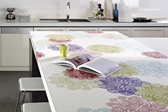
Laminate is incredibly popular – and not just because it’s so affordable. Laminate is long-lasting, easy to maintain, and can be made in all sorts of shapes, patterns and colours to suit just about any kitchen.

What are laminate benchtops?
Laminate, for the technically inclined, is more accurately described as cellulose-reinforced plastic, or even more specifically, high pressure melamine and phenyl formaldehyde laminate. Laminate benchtops normally consist of a layer of plastic laminate, glued to a block of engineered wood like particleboard or medium density fibreboard (MDF).
The laminate surfaces used on kitchen benches are known as ‘decorative laminates’. These are made using decorative papers, which allow for a very broad range of colours and textures – and using the right products and finishing techniques, laminate benchtops can even be made to fairly convincingly mimic things like marble and granite.
Plastic laminates first hit the market in 1913, and have been a popular choice in kitchens for decades.
What are the properties of laminate benchtops?
Laminate benchtops are the most popular type of kitchen benchtop in Australia – thanks in no small part to the fact that they’re normally far more affordable than most other options. Laminate benchtops can be cut into any size, and are available in a limitless range of finishes and colours. Some manufacturers even offer the ability to create your own custom designs and patterns. Laminate benchtops are easily fitted to most kitchens, and can readily be cut on site.
As well as being versatile and easy to install, laminate benchtops can stand up to quite a bit of abuse. Laminate benchtops adhere to some very strict standards (Australian Standards AS/NZS 2924.1) in relation to their anti-microbial properties, fire resistance and resistance to wear, among other things. The laminate benchtops of today are extremely durable, versatile and cost effective options for your kitchen.
Depending on how they’re made, laminate benchtops won’t necessarily have the same feel or finish as a natural product like granite – nor will they be as prestigious or as valuable for resale, in most cases – but they’re a very cost-effective alternative.
Maintenance of laminate benchtops
Laminate benches don’t require the same attention and maintenance as finishes like stone might – although they are susceptible to damage when exposed to heat, so it’s important not to put any hot pots and pans on them. Likewise, although they’re resistant to some wear, laminate surfaces will still scratch and mark if you cut veggies directly on the bench surface.
Being cellulose-based, laminates behave much like wood. Low humidity may cause them to shrink, while high humidity can lead to expansion, so both the laminate and the material to which it’s being applied should be treated to prevent this from happening.
Where possible, joins in laminate benchtop surfaces should be a minimum of two metres apart, and kept to a minimum number.
|
Advantages
|
Disadvantages
|





